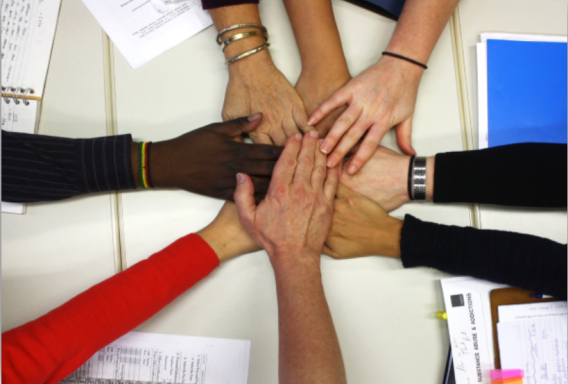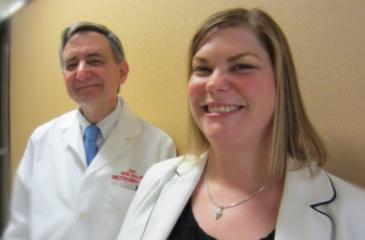When a Hennepin County Medical Center (HCMC) research team received their grant critique, it became clear they’d need to strengthen their project’s statistical approach in order to receive funding.
They pulled in biostatisticians from CTSI’s Biostatistical Design and Analysis Center (BDAC) who consulted on study design, made sample size and power calculations, and rewrote the proposal’s statistical analysis section.
Winning grants with the help of CTSI biostatisticians
Support from CTSI’s biostatistical team ultimately helped take the proposal across the finish line to receive a $607,300 grant from the Agency for Healthcare Research and Quality (AHRQ), as Sara Poplau, Senior Research Project Manager and Assistant Director of HCMC’s Office for Professional Worklife (OPW), explains:
“The statistical section of our grant went from being okay to knocking it out of the park. CTSI biostatisticians are true partners who took the time to understand what we were trying to accomplish, and transformed our statistical analysis in a way that helped result in funding.”
The project aims to determine whether electronic health records (EHRs) are compounding physician burnout and stress, an issue that HCMC PI Mark Linzer, MD, describes as an epidemic. Physician burnout affects more than half of U.S. physicians and is on the rise, he explains, pointing to a Mayo Clinic study.
As of March 2017, Dr. Linzer, Poplau, and team are analyzing the study data and writing up results that will be submitted for publication.
“CTSI’s statistical expertise elevated the overall quality of our research,” says Dr. Mark Linzer, HCMC’s General Internal Medicine Division Director and Director of the Center for Patient and Provider Experience. “We’ve learned so much from CTSI biostatisticians, and the grant applications we collaborate on have been extremely well received.”
Growing into an ongoing partnership
What started as a one-off project blossomed into a standing CTSI-HCMC partnership with multiple grants and manuscripts.
HCMC is one of CTSI’s hub partners, and the two organizations now pursue a portfolio of collaborative research activities.
Together, they aim to enhance the way discoveries are translated into practice to improve human health, share best research practices, and solve health problems faced by Minnesotans. Other CTSI hub partners are Fairview Health Services and the Minneapolis VA Health Care System.
CTSI biostatisticians -- several of whom have their academic home within the University’s School of Public Health -- have supported numerous HCMC projects by providing statistical and data management support throughout a study’s lifecycle, from study design to final analysis and publication.

Finding new ways to support disadvantaged patients
CTSI’s biostatistical team has continued partnership with HCMC in a study evaluating a unique Medicaid accountable care organization that’s attracted national attention, including a New York Times article.
Called Hennepin Health, the program aims to simultaneously save healthcare costs while better meeting the complex needs of Hennepin County residents who are grappling with health problems and poverty.
The idea is to get to the root issue that’s driving avoidable use of the hospital and emergency department among Medicaid patients by going beyond medical care to provide behavioral health support and social services.
An individual might show up at the emergency department when a health issue has spiraled out of control, or they simply need a warm place to stay and have nowhere else to go. Providers quickly realize the patient needs more than medical care, which is when Hennepin Health comes into the picture.

In addition to receiving medical care, an individual in Hennepin Health might receive support from a community health worker who connects them with stable housing, counseling, employment training, and other resources.
Hennepin Health shows promising preliminary results, with individuals enrolled in the program crediting it with getting their life back on track and HCMC’s emergency department spending 52 percent less on program members who’ve received housing support.
But there’s still more to understand about the program’s comprehensive impact on patients and providers. Specifically, how do Hennepin Health patients fare compared to similar patients not enrolled in the program?
CTSI biostatisticians Jeremiah Menk, MS, and John Connett, PhD, are helping to answer this question, as one part of a multi-disciplinary HCMC-University research team that includes HCMC clinician-investigators Kate Diaz Vickery, MD, MSc, and Mark Linzer, MD, as well as PI Nathan Shippee, PhD, a sociologist and Assistant Professor with the University’s School of Public Health. Hennepin Health leader Ross Owen and senior analyst Dana Soderland have also participated as partners in the research effort.
With the support of a grant from The Commonwealth Fund, the research team is determining whether Hennepin Health is making a difference, and for which individuals.
Overcoming complex data challenges
To do this, the team is blending quantitative and qualitative sources to better understand the Hennepin Health program. While the approach promises to be eye-opening, it also poses a number of data-related challenges.
In the qualitative work, they’re studying the experiences of patients in Hennepin Health -- many of whom have multiple physical and mental illnesses, substance use disorders, and homelessness -- as well as the experiences of their providers.
In the quantitative work, the team is comparing Hennepin Health patients with similar Medicaid patients from Hennepin and Ramsey counties not enrolled in the program. For these comparisons, the team relies on health care claims/billing information as their primary data source.
Yet this presents a challenge since information about homelessness and other social issues can be difficult to glean from claims data. So the team had to find another way to gather that information.
In addition, the research team had to overcome inherent biases in the data.
Because Hennepin Health was the default choice for new Medicaid enrollees in downtown Minneapolis who did not respond to paperwork, it led to a disproportionate number of homeless people enrolling in the program (most homeless shelters are near HCMC, in the downtown area). This is one of the many adjustments the research team would need to make when evaluating the program.

Incorporating state-of-the-art statistical science
CTSI biostatisticians helped the research team overcome these challenges and set up the study in a way that would enable them to make adequate comparisons about various social issues, and ultimately measure the program’s impact.
A key part of the CTSI biostatisticians’ role was leading efforts to evaluate the tradeoffs of various statistical approaches. CTSI biostatisticians worked closely with the researchers to select an approach that would enable the research team to use statistical adjustments in a way that creates conditions similar to a randomized controlled trial.
“CTSI biostatisticians helped our team understand and assess our options, and eventually select a sound statistical approach that’s uncovering new insights on our research topic,” says Dr. Kate Vickery, an HCMC primary care doctor and Assistant Professor with the University’s Medical School. “As a junior faculty member, it has been especially helpful to learn from experts who have a knack for helping researchers better understand biostatistics and how to leverage it for health studies.”
The research team – including Drs. Vickery, Linzer, and Shippee, partners from Hennepin County, as well as CTSI biostatisticians – meets regularly about the project, collaborating to weave various pieces of the dataset together in a coherent, rigorous way.
Developing novel approaches for collecting data
To overcome the bias related to the disproportionate number of homeless people enrolled in Hennepin Health, the team developed a novel way to flag homelessness, since the factor typically isn’t included in health care claims.
CTSI biostatisticians partnered with the county, HCMC, and the study team to create an identifier that flagged an individual’s address on a health care claim as matching that of a homeless shelter.
They compared addresses from Medicaid enrollment records with a time-stamped field collected in HCMC’s electronic health record from a questionnaire asking if a patient is homeless. This ultimately enabled the project team get the data necessary to better understand the population they were trying to help.
“CTSI biostatisticians have been exceptional partners,” says Dr. Linzer. “They are a trusted team of mentors and colleagues; our group has grown so much from their expertise.”
Measuring a program’s impact
The team has shared preliminary findings from this work with several national audiences. As of March 2017, they are finalizing the remaining analyses and preparing to submit abstracts and papers to national meetings and journals.
One initial finding from the team’s qualitative analysis is that people who seek out primary care, have a trusting, strong relationship with their primary care provider or clinic, and routinely receive mental health care report a higher quality of life.
Blending insights like this with the results of the quantitative analysis will allow the providers and agencies who run Hennepin Health understand how the program is working, and for which kinds of people. Insights can also aid similar organizations across the country in understanding how to build resource-conscious programs that effectively integrate medical care with other non-medical support mechanisms, explains Dr. Vickery:
“We hope our findings will ultimately help communities build programs that meet the complex needs of disadvantaged patients. I believe there’s a way to create smart care programs that are a win-win for all involved, but we need to do rigorous evaluation to ensure we understand if and how they’re working.”
